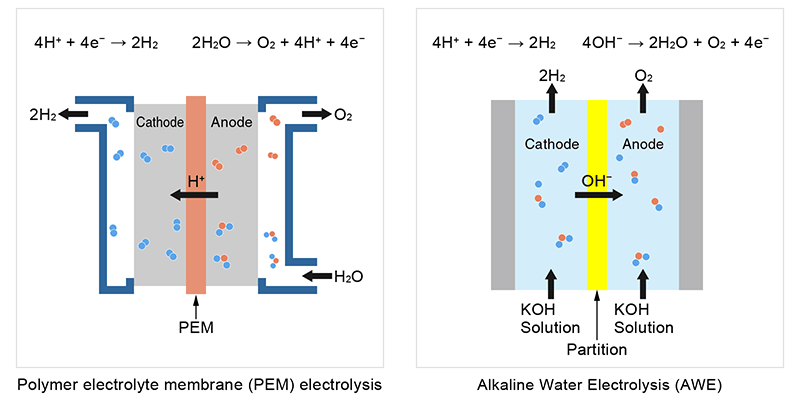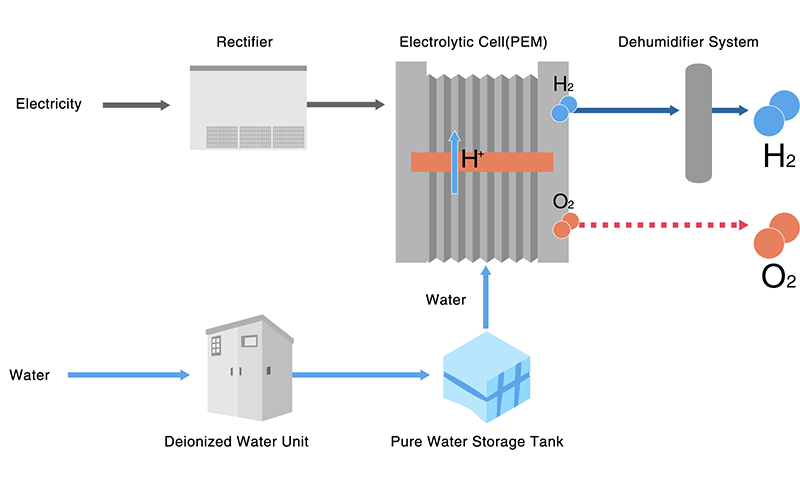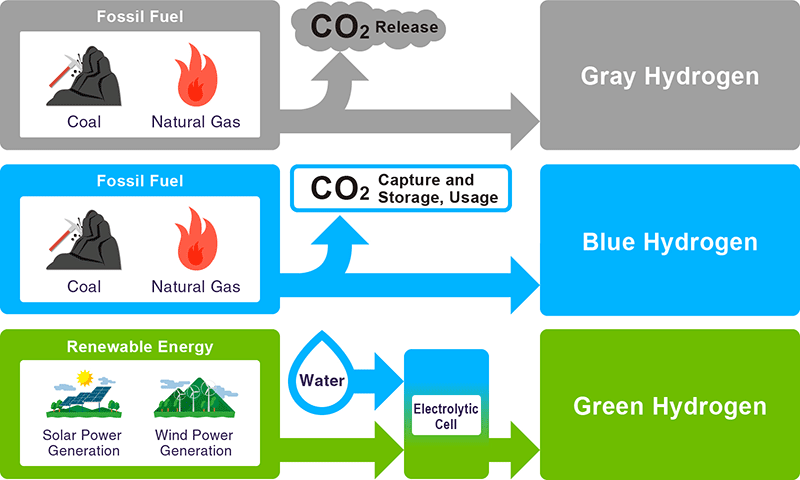
This article introduces "hydrogen", which is the next-generation energy to realize carbon neutrality. There are three types of hydrogen: "green hydrogen", "blue hydrogen", and "gray hydrogen", each of which has a different manufacturing method. We will also explain each manufacturing method, physical properties as an element, storage/transportation method, and usage method. And I will also introduce the reason why it is the leading energy of the next generation.
Production of Green Hydrogen by Electrolysis of Water
When using hydrogen, it is important to "produce hydrogen" anyway. And the easiest way is "electrolysis of water". As is commonly demonstrated in elementary school science. Fill the beaker with water and the electrodes in the water. When a battery is connected to the electrodes and energized, the following reactions occur in water and in each electrode.
Cathode: 2H2O + 2e- → H2 + 2OH-
Anode: 2H2O → O2 + 4H+ + 4e-
At the cathode, H + and electrons combine to generate hydrogen, while the anode produces oxygen. However, this method is fine for school science experiments, but in order to generate hydrogen industrially, you must prepare an efficient mechanism suitable for mass production. That is "Polymer electrolyte membrane (PEM) electrolysis".

In this method, a polymer semipermeable membrane that allows hydrogen ions to pass through is sandwiched between the anode and cathode. When water is poured into the anode of the device, the hydrogen ions generated by electrolysis move to the cathode through the semipermeable membrane, where they become hydrogen molecules. On the other hand, oxygen ions cannot pass through the semipermeable membrane and become oxygen molecules at the anode.
Also, in Alkaline water electrolysis, you generate hydrogen and oxygen by separating the anode and cathode through a partition through which only hydroxide ions can pass. Other than that, there are industrial methods such as high-temperature steam electrolysis.
By doing these methods on a large scale, large quantities can be obtained a lot of hydrogen. In this process, a large amount of oxygen (half of the generated hydrogen in terms of volume) is also generated, so if it is released into the atmosphere, it will not have an adverse effect on the environment. However, electrolysis requires a large amount of electricity, so if you make it with electricity that does not use fossil fuels, such as wind turbine generation and solar panel power generation, you can make hydrogen without carbon.
You can procure "green hydrogen" by electrolyzing water with clean energy.

There is also a hydrogen generator for the mass production of this green hydrogen. By adopting PEM for the electrolytic cell part, you can generate hydrogen continuously.
Blue Hydrogen Made from Fossil Fuels
So, what are the other ways to make hydrogen? Hydrogen is abundant in fossil fuels such as natural gas and coal as substances other than water. For example, consider methane (CH4), which is the main component of natural gas. There are four hydrogen atoms here. You can get hydrogen by extracting this hydrogen.
One of them is a method called "steam methane reforming" that uses steam. The chemical formula by this method is as follows.
CH4 + H2O → CO + 3H2 -206.1kJ/mol
As you can see, it is possible to extract carbon monoxide and hydrogen from a single methane molecule.
By using methods such as "steam reforming" and "pyrolysis" of natural gas and coal in this way, you can produce hydrogen. "Blue hydrogen" refers to the hydrogen produced in this way.
However, in this case, carbon monoxide and carbon dioxide are generated as by-products. So you have to recover them so that they are not released into the atmosphere. If the by-product carbon dioxide cannot be recovered, it becomes hydrogen called "gray hydrogen".

(Source: Agency for Natural Resources and Energy [Japanese] https://www.enecho.meti.go.jp/about/special/johoteikyo/suiso_tukurikata.html)
What Kind of Element Is Hydrogen?
So, what kind of element is hydrogen?
Hydrogen has an atomic number of 1 and appears first in the Periodic Table of the Elements.
The number of atoms is the largest in the universe, boasting an overwhelming number of about 90% of all elements existing in the universe. The smallest atom composed of one proton and one electron is a hydrogen atom.
As introduced in "Differences between fusion power generation and nuclear power generation", hydrogen has two isotopes with neutrons attached to the nucleus. "Deuterium" with one neutron bonded and "tritium" with two neutrons bonded. These are also materials for fusion power generation.
Inside a star such as a sun, a nuclear fusion that changes from hydrogen to helium is taking place, and it is an energy source when the star shines.
However, hydrogen rarely exists as a gas on the Earth. Hydrogen makes compounds with other elements such as water, methane, ammonia, and ethanol. Since hydrogen is a light element, the speed of hydrogen molecules increases as the temperature rises, and it escapes into outer space by shaking off the gravitational force of the earth.
How to Use Hydrogen? -Use by Combustion-
By the way, how is "hydrogen", which the world is paying attention to as the next-generation energy, used? There are two main ways to use it: "combustion" and "fuel cell". Let's start with the use by "combustion".
There are two main types of use by combustion.
The first is as rocket fuel. Japan's H-IIA rocket uses hydrogen "liquid hydrogen", which is liquefied by cooling to a low temperature, and "liquid oxygen", which is also at a low temperature, as fuel. These two types are combined, and the heat energy generated at that time accelerates and injects the generated water molecules and flies to space. However, since it is a technically difficult engine, only the United States, Europe, Russia, China, and India have succeeded in combining this fuel except Japan.
The second is power generation. The method of utilizing the energy generated when hydrogen combines with oxygen is also adopted in gas turbine power generation. In other words, it is a method that focuses on the heat energy generated by hydrogen. At thermal power plants, the heat generated by burning coal, oil, and natural gas produces steam to turn turbines. If you use hydrogen as a heat source, the power plant will be carbon neutral.
How to Use Hydrogen? - Used as A Fuel Cell-
Another way to use hydrogen is as a fuel cell that directly converts it into electrical energy. In particular, as part of global warming countermeasures, Toyota has promoted that the alternative to gasoline-powered vehicles is hydrogen-fueled vehicles instead of electric vehicles (EVs), which is a usage that is drawing attention in Japan.
Specifically, we are doing the reverse procedure when we introduced the manufacturing method of "green hydrogen". The chemical formula is as follows.
2H2 + O2 → 2H2O
The fact that hydrogen generates water (hot water or steam) at the same time as power generation is a point that can be evaluated because it does not impose a burden on the environment. On the other hand, this method has a relatively low power generation efficiency of 30-40% and requires platinum as a catalyst, so it is necessary to improve the cost.
Currently, we are using polymer electrolyte fuel cells (PEFC) and phosphoric acid fuel cells (PAFC). In particular, fuel cell vehicles use PEFCs, so they can be expected to become widespread in the future.
Is Hydrogen Storage and Transportation Safe?
By now, we think you have understood how to make and use hydrogen. So how do you store this hydrogen? And how do you get it where you need it? Safety during storage and transportation is a critical consideration.
In fact, hydrogen is also a very dangerous element. At the beginning of the 20th century, we used hydrogen as gas to float balloons, balloons, and airships in the sky because of its lightness. However, on May 6, 1937, in New Jersey, USA, the "Airship Hindenburg explosion" has occurred.
Since this accident, there has been widespread recognition that hydrogen is dangerous. Especially when there is a fire, it violently combines with oxygen and explodes. For that reason, "Keep away from oxygen" or "Keep away from heat sources" is indispensable.

After taking these measures, we have come up with a method for transportation.
Hydrogen at room temperature is a gas, so it is very bulky even if it remains a gas. The first method is to apply high pressure and compress it like a carbonated cylinder when making carbonated drinks. Prepare a dedicated high-pressure tank and store it under high pressure such as 45Mpa.
Toyota, which develops fuel cell vehicles (FCVs), is developing a resin high-pressure hydrogen tank that can withstand 70 MPa.
There is also a method of cooling to -253 ° C to make liquid hydrogen and storing and transporting it in a dedicated heat shield tank. Just like LNG (liquefied natural gas) when importing natural gas from other countries, hydrogen is liquefied for transportation so that its volume is reduced to 1/800 of the gaseous state. In 2020, we completed the world's first liquefied hydrogen carrier. However, this method is not suitable for FCVs because it costs a lot of energy to cool.
There is a method of storing and transporting in a tank like this, but we are also developing other storage methods in the case of hydrogen.
The storage method is to use a hydrogen storage alloy. Hydrogen has the characteristic of penetrating into metals and deteriorating it. This was a development hint and was developed in the United States in the 1960s. J.J. Reilly et al. Experimentally proved that alloys using magnesium and vanadium store and release hydrogen.
After that, he succeeded in developing a substance that occludes 935 times as much hydrogen as its own volume, such as palladium.
The advantage of using this alloy is that it can prevent accidents due to hydrogen leakage (mainly explosion accidents). Therefore, it is possible to safely store and transport. However, if you are not careful and place it in an inappropriate environment, the hydrogen storage alloy will release hydrogen over time. Then, even a small spark will cause an explosion accident, so be careful.
It also has the disadvantage that repeated occlusion and release of hydrogen causes brittleness and lowers the occlusion rate.
The other is to use a pipeline. There is a condition that it must be uncompressed and low pressure to prevent embrittlement of the pipe, but the advantage is that existing gas pipes can be used. Tokyo Gas has carried out construction work on Harumi FLAG to supply hydrogen to fuel cells using piping for city gas.

Future Society Created by Hydrogen Energy
Finally, let us consider what role hydrogen energy plays in society.
To promote a carbon-free society, using hydrogen to generate electrical energy is more critical than using it merely as a heat source.
Instead of large-scale thermal power plants, some households have introduced systems such as ENE-FARM that use hydrogen obtained by reforming natural gas to generate the electricity they need. However, the problem of how to treat by-products during reforming remains.
In the future, if the distribution volume of hydrogen itself increases, such as by increasing the number of hydrogen stations, it will be possible to use electricity without emitting carbon dioxide. Of course, electricity produces green hydrogen, so this uses electricity generated using sunlight or wind power. The electricity used for electrolysis should be the one that suppresses the amount of power generation or charges the rechargeable battery when there is surplus electricity from natural energy. In other words, hydrogen is in the same position as a rechargeable battery. If that happens, it will eventually be possible to reduce thermal power generation. The day when the internal combustion engine will disappear from the car will soon come.
Hydrogen is also available via another route. In fact, hydrogen is still a by-product of the production of caustic soda. Besides that, it is also a by-product of coke production for iron making. If you put this hydrogen in the distribution, you will be able to obtain multiple sources. Hydrogen gas stations also provide hydrogen produced in this way.
Let's look at the future a little further. The amount of energy loss is also a problem with the method of transmitting electricity using electric wires to supply electric power. Therefore, in the future, we will use the hydrogen sent from the pipeline, buy a hydrogen tank at home like a carbonic acid cylinder used when making carbonated drinks, and generate electricity at each home. Mobile devices that run on batteries that use hydrogen are becoming commonplace ... It would be interesting to see such a future.
Related Technical Articles
Recommended products
We at Matsusada Precision provide manufacturing and selling services for versatile power supplies. We focus more on regenerative power supplies and electronic loads used for developing various fuel cells and performance evaluation of fuel cell stacks.
Reference (Japanese site)
- Japanese source page 「次世代エネルギー「水素」のすべて 」
(https://www.matsusada.co.jp/column/next-gen_energy_hydrogen.html) - 日刊工業新聞社 「とことんやさしい水素の本」
(https://pub.nikkan.co.jp/book/b10021404.html) - 3種類の水素について:グレー水素・ブルー水素・グリーン水素(三菱重工)
(https://spectra.mhi.com/jp/what-are-the-three-colors-of-hydrogen) - グリーン水素・ブルー水素(Sustainable Japan)
(https://sustainablejapan.jp/2021/02/10/グリーン水素・ブルー水素/58912) - 燃料電池車(FCV)のしくみ(JHFCサイト)
(https://www.jari.or.jp/jhfc/beginner/about_fcv/index.html) - トヨタ、樹脂製高圧水素タンクを活用した貯蔵モジュールを開発
https://global.toyota/jp/newsroom/corporate/36999981.html - パナソニック、水素で発電する純水素型燃料電池を10月発売--脱炭素社会へ
(https://japan.cnet.com/article/35169122/) - 水素を利用した"高効率な発電機" 家庭に設置する燃料電池の開発
(https://www.nedo.go.jp/hyoukabu/articles/201014tokyo_gas/index.html) - 世界初の液化水素運搬船向け「海上輸送用液化水素タンク」の搭載が完了(川崎重工)
(https://www.khi.co.jp/pressrelease/detail/20200309_1.html) - 水素ガスは既設のガス管でほぼOK、電柱にパイプを通す構想も(日経XTECH)
(https://xtech.nikkei.com/atcl/nxt/column/18/01513/00002/) - Hydrogen Production: Electrolysis
(https://www.energy.gov/eere/fuelcells/hydrogen-production-electrolysis) - 水素製造システム(第5回)電解による水素製造(2)(九州大学)
(https://i2cner.kyushu-u.ac.jp/~matsumoto/wp01/wp-content/uploads/2018/11/IM820_HydrogenProductionSystem_5_2018.pdf) - 次世代エネルギー「水素」、そもそもどうやってつくる?(資源エネルギー庁)
(https://www.enecho.meti.go.jp/about/special/johoteikyo/suiso_tukurikata.html)




